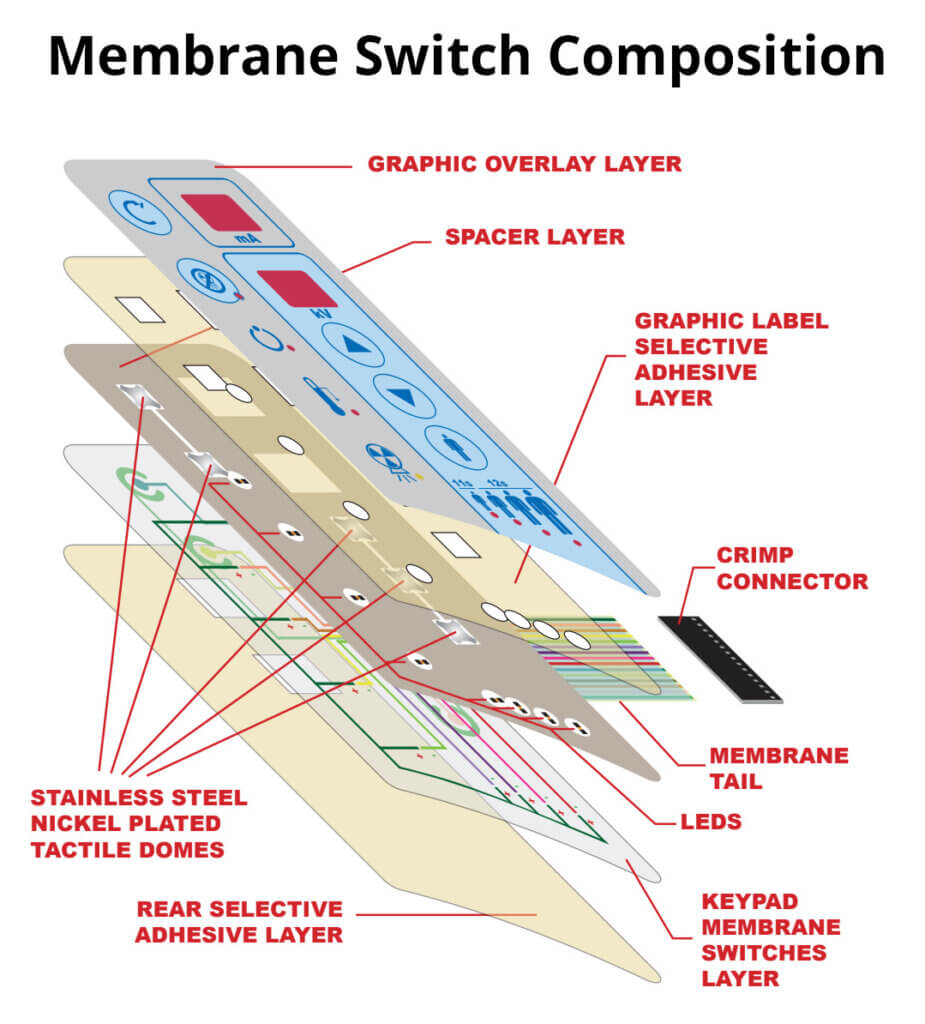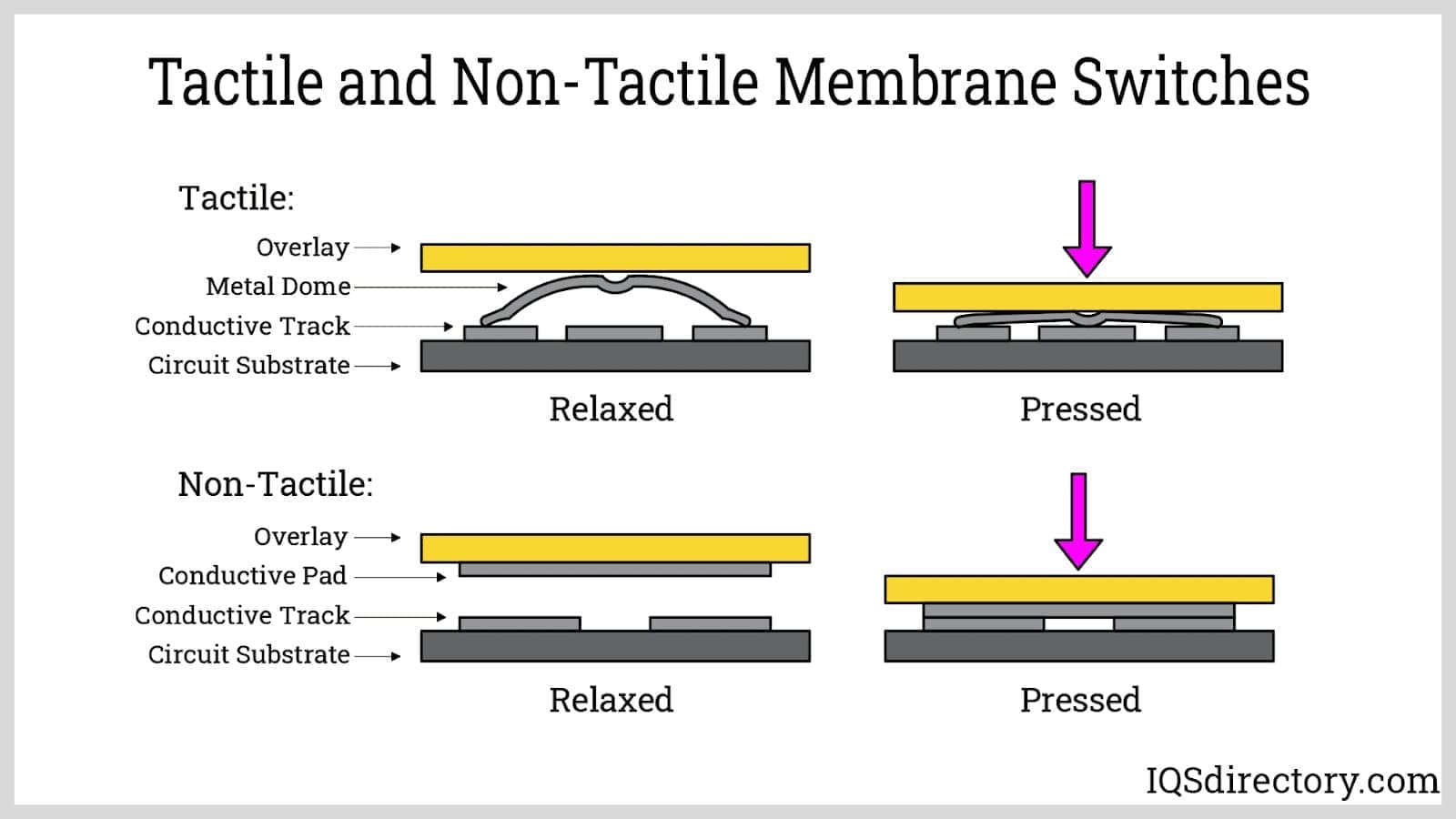Membrane Switch Manufacturer Serving Medical and Aerospace Industries
Membrane Switch Manufacturer Serving Medical and Aerospace Industries
Blog Article
Recognizing the Importance of Membrane Switch in Modern Electronics and Their Applications
Membrane switches act as a crucial component in contemporary electronics, offering an efficient interface for user communication. Their customizable and light-weight nature makes them appropriate for a series of applications across varied markets. Understanding their crucial elements and benefits can give understandings into their growing importance. As technology continues to advancement, the advancement of Membrane switches increases questions concerning their future applications and style technologies. What lies ahead in this vibrant area?

What Are Membrane Switches?
Membrane switches are necessary components in modern-day electronic devices, working as interface that promote interaction between gadgets and individuals. These buttons contain numerous layers, including a visuals overlay, an adhesive layer, and a circuit layer, all of which collaborate to create a durable and practical interface. The layout allows for a flat, low-profile service that can be customized concerning size, shape, and visual look, making them appropriate for various applications, from customer electronics to clinical devices. The responsive responses provided by Membrane changes boosts user experience, while their resistance to dirt and wetness makes them optimal for challenging atmospheres. Membrane switches can incorporate functions such as backlighting and printed graphics, additionally expanding their usability. Their versatility and robustness make them a favored choice in industries where reliability and ease of use are paramount, ultimately adding to the seamless operation of modern-day electronic gadgets.
Key Parts of Membrane Changes
While different parts contribute to the performance of a membrane layer switch, three primary layers play considerable functions in its style and operation. The leading layer, commonly made from a sturdy polymer, works as the user interface for customer interaction, usually including printed graphics and symbols. Below this is the spacer layer, which keeps the required distance between the leading layer and the circuit layer. This spacer layer warranties that the button triggers only when pushed, preventing unexpected inputs. Finally, the circuit layer consists of conductive traces that complete the electric circuit when the top layer is depressed. These traces can be made from different materials, consisting of copper or silver. With each other, these parts develop a reliable and durable gadget that is portable and functional, appropriate for a large range of electronic applications, from family devices to medical gadgets. Recognizing these essential parts is crucial for valuing the general performance of Membrane buttons.
Advantages of Using Membrane Switches Over

Membrane Switch Manufacturing Process
Understanding the Membrane switch production procedure reveals the intricate steps associated with producing these crucial components. The process typically starts with the design phase, where specifications and layouts are created using specialized software program. Following this, the visuals overlay is published on a versatile substrate, frequently making use of high-resolution printing methods to guarantee clarity and precision.Next, the glue layers are applied, which offer to bond the various elements with each other. The circuit layers, made from conductive inks or products, are after that printed onto a separate substrate. These layers are very carefully lined up and laminated flooring to develop a functional switch.After setting up, the buttons undergo evaluating to confirm functionality and sturdiness. Quality control measures are implemented throughout the process to recognize and correct any issues. The completed Membrane switches are packaged and prepared for distribution, prepared to satisfy the needs of contemporary electronic applications.
Applications of Membrane Switches in Different Industries
Membrane switches are significantly made use of throughout different industries, particularly in medical devices and customer electronic devices. In the medical area, they give reputable control user interfaces for tools that require exact operation. In customer electronic devices, these buttons improve individual interaction by using sleek and receptive interfaces. Receptive Medical Tools Control
Countless modern-day clinical devices use Membrane buttons for structured procedure and boosted user communication. These buttons give a dependable, long lasting interface for a range of applications, consisting of diagnostic tools, patient monitoring systems, and surgical tools. Their adjustable designs permit details layouts that can suit the one-of-a-kind needs of health care experts, making sure user-friendly navigating and effective accessibility to crucial functions. Furthermore, Membrane buttons are resistant to contaminants, making them suitable for sterile environments. The tactile feedback they offer can enhance user self-confidence, lowering the risk of errors during crucial clinical treatments. Overall, the integration of Membrane switches in clinical devices substantially contributes to improved operational effectiveness and individual safety in healthcare setups.
Consumer Electronics Interfaces
In the domain of consumer electronics, Membrane buttons play an important duty in enhancing user interfaces across a variety of gadgets. These switches are integral to items such as push-button controls, microwaves, and gaming consoles, offering a easy to use and effective user interface. Their layout enables for a seamless combination of graphics and capability, making it possible for makers to develop sleek, modern-day aesthetic appeals without jeopardizing use. Membrane buttons are likewise recognized for their durability, frequently withstanding considerable usage and direct exposure to various environmental conditions. In addition, they can include attributes like backlighting and responsive feedback, more boosting the individual experience. As customer demands for sophisticated yet user-friendly user interfaces grow, Membrane changes proceed to be a necessary element beforehand electronic tool capability.
Style Considerations for Membrane Switches
Creating efficient Membrane switches over calls for careful focus to different elements that influence both performance and customer experience. One important consideration is the selection of products, as they can impact durability, responsive responses, and aesthetic allure. Choosing an ideal adhesive is necessary for assuring long-term adhesion and resistance to environmental factors.In addition, the layout and style of the switch should accommodate Full Article customer communication, with button dimensions and spacing enhanced for ease of use. The incorporation of graphics and labeling ought to focus on clearness and presence under different lights conditions.Consideration of electrical features, such as actuation pressure and button sensitivity, will certainly boost the responsiveness why not try here of the Membrane switch. The layout ought to fit making processes to assure cost-effectiveness and prompt production. Overall, a well-balanced design boosts both the functionality and the user experience of Membrane buttons in contemporary electronic devices.

Future Patterns in Membrane Switch Technology
As technology continues to evolve, Membrane buttons are positioned to incorporate brand-new developments that will certainly enhance their performance and application in different fields. One significant fad is the consolidation of versatile and sturdy products, which will certainly increase the lifespan and reliability of these buttons. Improved surface textures and personalized graphics are additionally anticipated, enabling more intuitive customer interfaces.Moreover, the integration of smart technology, such as touch-sensitive surfaces and haptic responses, is anticipated to enhance customer interaction, making Membrane switches over extra interesting and responsive. In addition, breakthroughs in printed electronic devices will make it possible for more complicated wiring within thinner accounts, further expanding design possibilities.Sustainability will likewise play an important role in future developments, as producers explore eco-friendly materials and manufacturing processes. Overall, these fads will guarantee that Membrane switches over remain relevant and crucial in a increasingly electronic and interconnected globe.
Often Asked Concerns
Just How Do Membrane Switches Over Contrast to Typical Mechanical Switches?
Membrane switches over deal benefits over standard mechanical buttons, including lowered size, lighter weight, and improved sturdiness. They typically provide a secured surface, boosting resistance to dust and moisture, making them suitable for varied applications.
What Materials Are Generally Utilized in Membrane Switch Building?

Can Membrane Switches Withstand Extreme Environmental Issues?
Membrane buttons can stand up to severe environmental problems, relying on their style and materials. High-grade buildings typically feature toughness versus temperature level changes, moisture, and exposure to chemicals, making them ideal for various demanding applications throughout industries.
How Much Time Do Membrane Changes Usually Last Prior To Failing?
Membrane switches over usually exhibit a life-span ranging from 1 to 10 million actuations, depending upon aspects such as important source use regularity, environmental conditions, and manufacturing quality. Routine upkeep can expand their longevity and functional integrity substantially.
Are Membrane Switches Over Customizable for Certain Applications?
Membrane switches are indeed personalized for certain applications. They can be customized in size, functionality, and layout, enabling makers to fulfill distinct customer needs and improve item appearances while preserving operational efficiency and resilience. Membrane buttons are crucial elements in modern-day electronic devices, offering as individual interfaces that help with interaction between individuals and tools. The tactile responses offered by Membrane switches enhances customer experience, while their resistance to dust and dampness makes them optimal for testing settings. The incorporation of graphics and labeling need to prioritize quality and visibility under different illumination conditions.Consideration of electric qualities, such as actuation pressure and button sensitivity, will boost the responsiveness of the Membrane button. Boosted surface structures and adjustable graphics are additionally prepared for, allowing for more intuitive customer interfaces.Moreover, the integration of clever innovation, such as touch-sensitive surfaces and haptic responses, is expected to improve individual interaction, making Membrane switches over more responsive and engaging. Membrane switches over offer benefits over standard mechanical buttons, consisting of decreased dimension, lighter weight, and improved resilience.
Report this page